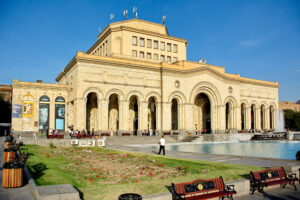Smbataberd Fortress (Armenia) – description, history, location. Exact address, phone number, website. Tourist reviews, photos and videos.
The Smbataberd Fortress, located on a hilltop east of Artabuynk village, Vayots Dzor region of Armenia, is a medieval fortification complex erected on the site of an ancient observation post of the 5th century. Scientists still haven’t determined after which Armenian ruler the fortress was named. The first on the list of possible contenders is a commander of the 6th century who became famous for his inhuman strength. Captured by the Byzantines, Smbat was forced to fight for his life in the arena with wild beasts. Defeating a bear, a bull and a lion, he earned the respect of all and was set free.
The life story of King Smbat I, who ruled in the 9th-10th centuries AD, was much more tragic: after many years of grueling struggle against the Arab Caliphate, he was captured and subjected to a painful execution – first they beheaded him and then crucified on the cross. Some researchers believe that the fortress was named in honor of Grand Prince Smbat II Tiezerakala Bagratuni, who came to power in the 12th century AD. This version raises some doubts due to the fact that the residence of the prince was located in Ani, a decent distance from Artabuynka, and to build a fortress in such a remote area was not profitable for him. Most scholars agree that the fortress was named after Smbat Orbelyan, the Prince of Syunik who lived in the 13th century. This truly great ruler knew five languages and was a born diplomat. He maintained friendly relations with the Mongol khan, so during his rule Armenia was exempted from paying tribute and the monasteries were returned the land expropriated earlier.
What to see
The fortress is crowned by the top of a hill located in the middle of a treeless area. It is surrounded on three sides by sheer cliffs that break off at the edge of the gorge, where the Artabun and Yeghegis rivers flow. It was accessible only from the north, through a massive wrought-iron gate guarded by archers. Should enemy detachments appear on the horizon, the locals were alerted to the danger by the fires lit on the watchtowers. They rushed inside the complex, the gates were locked by powerful bolts, and stones mixed with hot tar and boiling water fell on the heads of enemies who approached the walls of the fortress.
It was impossible to take the fortress by storm: there was no place to hide from arrows due to the lack of trees, and to storm the high stone walls, 2 to 4 meters thick, was tantamount to suicide. A siege of the fort also had no result: there was a secret water supply to the fortress, and there were plenty of food supplies in the warehouses.
During the whole time of Smbataberd’s existence it was captured only once, and only by cunning: the horses were fed with salt and allowed to graze in the vicinity of the fortress. Thirsty animals began to look for a place to drink, and dug a water pipe. By cutting off the water, the enemies forced the defenders of the fortress to surrender.
Although extensive reconstruction of the structure was carried out in 2006-2007, most of it now lies in ruins. Only the basalt wall encircling the complex by perimeter with semicircular bastions, 10 meters high and 3-4 meters wide, and some of the watchtowers, which used to be 10-11 meters high, are left of the once mighty fort.
Practical information
Coordinates of the fortress: 39°52’17.004″; 45°20’16.512″ It is accessible on foot, having overcome 2 km of country road, which begins at the village Artabuynk and goes into the mountains, or by off-road car.
Video:



